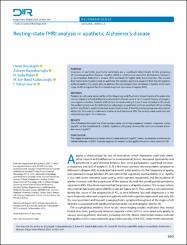| dc.contributor.author | Büyükgök, Deniz | |
| dc.contributor.author | Bayraktaroğlu, Zübeyir | |
| dc.contributor.author | Buker, Hediye Seda | |
| dc.contributor.author | Baral Kulaksızoğlu, Mehdiye Işın | |
| dc.contributor.author | Gürvit, İbrahim Hakan | |
| dc.date.accessioned | 2020-10-26T11:30:16Z | |
| dc.date.available | 2020-10-26T11:30:16Z | |
| dc.date.issued | 2020 | en_US |
| dc.identifier.citation | Büyükgök, D., Bayraktaroğlu, Z., Buker, H. S., Baral Kulaksızoğlu, M. I. ve Gürvit, İ. H. (2020). Resting-state fMRI analysis in apathetic Alzheimer's disease. Diagnostic and Interventional Radiology, 26(4), 363-369. https://dx.doi.org/10.5152/dir.2019.19445 | en_US |
| dc.identifier.issn | 1305-3612 | |
| dc.identifier.uri | https://dx.doi.org/10.5152/dir.2019.19445 | |
| dc.identifier.uri | https://hdl.handle.net/20.500.12511/5974 | |
| dc.description.abstract | PURPOSEDiagnosis of comorbid psychiatric conditions are a significant determinant for the prognosis of neurodegenerative diseases. Apathy, which is a behavioral executive dysfunction, frequently accompanies Alzheimer's disease (AD) and leads to higher daily functional loss. We assume that frontal lobe hypofunction in apathetic AD patients are more apparent than the AD patients without apathy. This study aims to address the neuroanatomical correlates of apathy in the early stage of AD using task-free functional magnetic resonance imaging (MRI).METHODSPatients (n=20) were recruited from the Neurology and Psychiatry Departments of Istanbul University, Istanbul School of Medicine whose first referrals were 6- to 12-month history of progressive cognitive decline. Patients with clinical dementia rating 0.5 and 1 were included in the study. The patient group was divided into two subgroups as apathetic and non-apathetic AD according to their psychiatric examination and assessment scores. A healthy control group was also included (n=10). All subjects underwent structural and functional MRI. The resting-state condition was recorded eyes open for 5 minutes.RESULTSThe difference between the three groups came up in the pregenual anterior cingulate cortex (pgACC) at the trend level (P = 0.056). Apathetic AD group showed the most constricted activation area at pgACC.CONCLUSIONThe region in and around anterior default mode network (pgACC) seems to mediate motivation to initiate behavior, and this function appears to weaken as the apathy becomes more severe in AD. | en_US |
| dc.description.sponsorship | Istanbul University | en_US |
| dc.language.iso | eng | en_US |
| dc.publisher | AVES | en_US |
| dc.rights | info:eu-repo/semantics/openAccess | en_US |
| dc.subject | Alzheimer | en_US |
| dc.subject | fMRI Analysis | en_US |
| dc.subject | Resting-State | en_US |
| dc.title | Resting-state fMRI analysis in apathetic Alzheimer's disease | en_US |
| dc.type | article | en_US |
| dc.relation.ispartof | Diagnostic and Interventional Radiology | en_US |
| dc.department | İstanbul Medipol Üniversitesi, Uluslararası Tıp Fakültesi, Temel Tıp Bilimleri Bölümü, Fizyoloji Ana Bilim Dalı | en_US |
| dc.department | İstanbul Medipol Üniversitesi, Rektörlük, Rejeneratif ve Restoratif Tıp Araştırmaları Merkezi (REMER) | en_US |
| dc.authorid | 0000-0001-5118-4776 | en_US |
| dc.identifier.volume | 26 | en_US |
| dc.identifier.issue | 4 | en_US |
| dc.identifier.startpage | 363 | en_US |
| dc.identifier.endpage | 369 | en_US |
| dc.relation.publicationcategory | Makale - Uluslararası Hakemli Dergi - Kurum Öğretim Elemanı | en_US |
| dc.identifier.doi | 10.5152/dir.2019.19445 | en_US |
| dc.identifier.wosquality | Q3 | en_US |
| dc.identifier.scopusquality | Q2 | en_US |


















